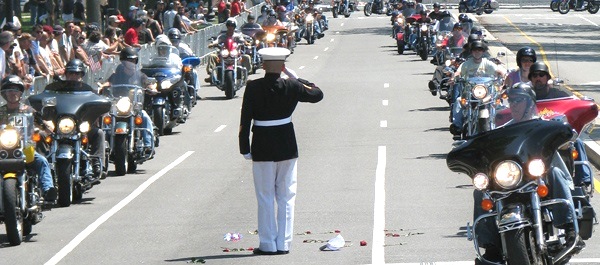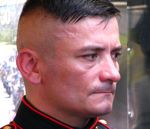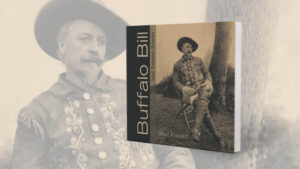
Chambers learned about discipline and hard work on his grandfather’s 500-acre strawberry farm in Oregon
Tim Chambers admits to an “overabundance of enthusiasm.” In his 15-year Marine Corps career, that enthusiasm served him well, leading to his series of Forrest Gump–like experiences. “You can get anywhere with enthusiasm,” said Chambers. Like onto the median of Washington’s 23rd Street in Marine dress blues during Rolling Thunder in 2002, snapping a salute to the bikers rolling by. Despite myriad challenges, Chambers hasn’t missed a Rolling Thunder since, becoming somewhat of a legend who is recognized by millions.
The eldest of six children, Chambers learned about discipline and hard work on his grandfather’s 500-acre strawberry farm in Silverton, Ore. “My grampa showed me how to be courteous, treat all people with respect and use common sense,” Chambers said. “And because he always kept his hoe close to my behind, it made the Marine Corps seem easy.”
Chambers joined the Marines after high school in 1994. From Parris Island on, he credits his energy and enthusiasm with helping him land many interesting jobs, including protocol chief to a general stationed in Japan and assistant to the chief defense counsel for the Marines in Washington.
Sergeant Chambers was also an ardent volunteer for organizations such as Special Olympics and the Muscular Dsytrophy Association. While stationed in Washington from 2000 to 2003, he participated in the World War II Memorial groundbreaking ceremony and the Korean War Commemoration Committee’s ceremonies for veterans who never received their medals. In 2003 Chambers’ volunteer work earned him recognition as one of five “Very Important Patriots” by the National Military Family Association—and because of that, his face appeared on the Kellogg’s Frosted Flakes cereal box.
On September 11, 2001, however, his energy and enthusiasm took a more dramatic turn in Washington. When the Pentagon was hit, he raced to the scene with other Marines and helped in the rescue efforts, entering the building to look for survivors and bodies. Two months later, Chambers and 10 other Marines were awarded the Navy and Marine Corps Commendation Medal. “The whole ordeal reminded me of why the Marine Corps exists,” said Chambers. “We are trained to react. It was a gut check and helped me decide to reenlist.” For his heroics, he was invited to the 2002 Rose Bowl parade to ride on a float with other 9/11 first responders.
Chambers first became aware of Rolling Thunder while he was stationed in Washington, and in 2002 the Marine decided to don his dress uniform and spend the day thanking veterans. But he didn’t think that was enough. He’d attended many funerals on behalf of the Marines, but felt giving a salute at a vet’s funeral was really too late. “That was it,” he said of his impulsive gesture. “I just jumped out there as the parade was happening and popped up a salute. Then I started thinking, ‘Can I make it to the end? If I fall out will I look like a complete idiot?’”
“I just got caught up in the moment,” he said, not thinking it would be more than just a one-time thing. The next year, though, Chambers began his salute at the very beginning of the motorcycle run and held it to the end.
Transferred to California in 2004, Chambers said his run might have ended then. Soon, though, he received validation of his Rolling Thunder salute in the form of a letter from Marine Commandant General Michael Hagee, who wrote about the letters he’d received praising Chambers’ action and congratulating him “for serving as a superb representative of our Marine Corps.”
“I was just floored,” Chambers said—and he felt determined to get back the next year. He arranged to take leave to get to Rolling Thunder each year after that, and he has even taken his mother and grandmother with him a few times. Three times he’s accompanied riders from the Run for the Wall or Carry the Flame groups.
By 2008 the Marine sergeant had become a Rolling Thunder fixture. That year, after giving the salute, Chambers got a call from an aide to President George W. Bush. He told Chambers the president had seen him that day, was very impressed, and invited him to a Memorial Day breakfast at the White House the next morning. Chambers took his grandmother along, and they met the family of Army Staff Sgt. Matt Maupin, who had been a POW in Iraq and whose remains had just been recently returned. Chambers recalled the Marine Commandant General James Conway’s reaction to seeing him: “He came up to me and said, ‘What are you doing here, Marine? Who invited you?’ I said, ‘The president did, sir!’ That was fun.”
 While Tim Chambers’ annual salute, which lasts three to four hours, is a feat in itself, a serious medical condition has made the last three years especially challenging for him. After surgery in 2005, he contracted a serious bacterial infection caused by Methicillin-resistant Staphylococcus aureus (MRSA). In Chambers’ case, the bacteria invaded his back muscles and causes flare-ups that require intense therapy and can leave him bedridden for months at a time.
While Tim Chambers’ annual salute, which lasts three to four hours, is a feat in itself, a serious medical condition has made the last three years especially challenging for him. After surgery in 2005, he contracted a serious bacterial infection caused by Methicillin-resistant Staphylococcus aureus (MRSA). In Chambers’ case, the bacteria invaded his back muscles and causes flare-ups that require intense therapy and can leave him bedridden for months at a time.
The recurring illness contributed to Chambers’ decision to leave the Marines in 2009. “The Marine Corps has been my whole life since high school,” he said, “but I knew I could no longer serve. I miss it a lot.”
For the last three years, Chambers has suffered flare-ups just prior to Rolling Thunder. In 2011 he was hospitalized for several months before the Memorial Day weekend. Added to that, Chambers also had a broken right wrist.
“The first hour is always hell and I have to fight mentally to keep from falling out,” he said. “Over the years, it hasn’t gotten easier. I really thought I was going to fall out last year.” But even though he was clearly struggling, Chambers held his salute until the last bike passed.
“I’ll be in better shape this year,” Chambers said in March, noting that the MRSA infection had not returned. “The biggest concern I have is fitting into my uniform,” he said. “I’m 36 now and have been so sick the past few years that I haven’t had much opportunity to work out. But, really it’s more of a mental thing. I’m always thinking, ‘If I drop my salute, can I find a rock I can crawl under?’”
What mostly runs through Chambers’ mind during the salute are thoughts about what he is representing and who he is reaching. “Service members truly have compassion and love for each other,” he said. “The country needs to see this, and Rolling Thunder brings it to life. I feel the need to thank them for doing it.”
“I’m floored any time I hear that I’ve touched someone,” said Chambers. “Whenever a mother says I remind them of a son who died—be it in Desert Storm, Iraq, Afghanistan or even Vietnam—it completely blows me away. And when they tell me their stories, I will then tell them to others. Mission accomplished.”
And it’s not just a one-way experience for Chambers, who never served in combat. “When the vets stop and salute me, or when active duty soldiers and Marines get off their bikes, it validates me—even though they see what’s not on my chest,” he said. “As long as I am honoring and emulating them and helping people to remember their service and sacrifice, I hope that I will be accepted.”
While Tim Chambers admitted to having a few mental tricks to sustain him through the salute, he said he’s found something else that gets him through it. “It’s amazing,” he said. “When the bikes come right by me, the vibrations of the engines run through my body, and it takes away the pain in my arm. I especially love it when they rev up their engines and look me right in the eye and say, ‘Looking good, Tim!’ It means so much to be remembered and respected. There’s nothing better than that.”




